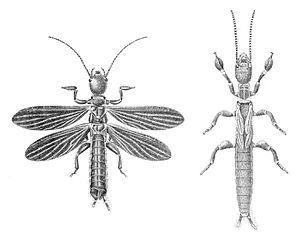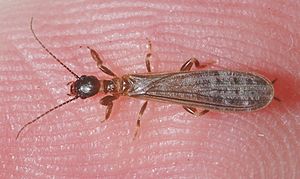Webspinners facts for kids
Quick facts for kids EmbiopteraTemporal range: Jurassic – Recent
|
|
|---|---|
 |
|
| Scientific classification | |
| Kingdom: | |
| Phylum: | |
| Class: | |
| Subclass: | |
| Infraclass: | |
| Order: |
Embioptera
|
| Families | |
|
There are two suborders and ten families |
|
The Embioptera are a group of insects. They are commonly known as webspinners. These insects are special because they can spin silk. They use this silk to build tunnels and homes.
Webspinners are a small group of insects. Most of them live in warm, tropical places. They are part of the Pterygota group. This group includes insects that have wings. Webspinners first appeared a very long time ago. They lived during the Jurassic period. This was the time of the dinosaurs! Scientists have found many webspinner fossils. These fossils are often found in Cretaceous amber. Amber is fossilized tree sap. It can preserve insects perfectly.
Contents
Amazing Silk Spinners
The name "webspinner" comes from their unique ability. They can spin silk. This silk comes from special glands. These glands are on their front legs. They use the silk to create web-like tunnels. These tunnels are called galleries. Webspinners live inside these galleries. The galleries protect them from predators. They also keep them safe from bad weather.
What Do Webspinners Eat?
Webspinners are not picky eaters. They feed on different things. They eat leaf litter that falls on the ground. They also eat moss and bark. Sometimes they eat lichen. Lichen is a type of fungus and algae that grows on trees and rocks.
Where Do Webspinners Live?
Most webspinners live in tropical areas. They prefer warm and humid places. Sometimes, they travel to cooler countries. They usually arrive as passengers on cargo ships. This means they accidentally hitch a ride.
Images for kids
-
Drawings of Embia major winged male, male nymph and adult female "from the Himalayas" by Augustus Daniel Imms, 1913
-
First instar larva in gallery
See also
 In Spanish: Embiópteros para niños
In Spanish: Embiópteros para niños








